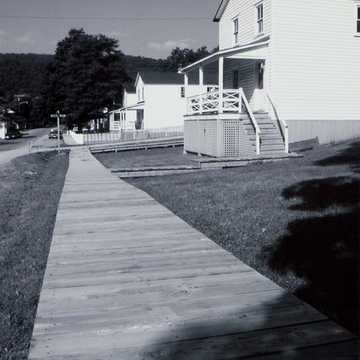The streets of residential Cass are arranged in a compact grid pattern along the slope of Back Mountain, northwest of the Greenbrier River. Reconstructed boardwalks provide pedestrian access throughout the area. As was typical of company towns, house types range in size and degree of decoration according to the rank of the worker whose family occupied them. Class 1 houses were for managers, class 2 for section foremen and office workers, and class 3 for day laborers. Surprisingly, locations of the several classes are not as rigidly defined or concentrated as was usual in company towns.
The majority of the housing stock, class 3, are rectangular (20-by-30-foot), two-story, frame houses clad in German siding. Gable ends face the street, and each house has one-story, shedroofed front and rear porches. Small fuel storage sheds, some of which remain, originally opened on the alleys behind the houses.
Class 2 houses are concentrated near the store and depot. They have more variety in plan, are larger, and have more generous front porches. In addition, they display a modicum of decoration in the form of railings, porch columns, and round, louvered ventilators in gable ends.
The few class 1 houses stand above the store and depot in a random pattern on the slope of Big Bug Hill, also known as Snob Hill or Quality Hill. Reached by boardwalks, including one






